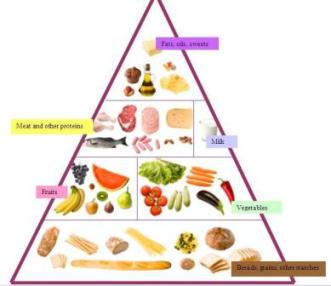Diabetes Food Pyramid
Understanding the Diabetes Food Pyramid is a key component in building your diabetic meal plan.The American Diabetes Association has created the this food pyramid for diabetics to make it easier for you to choose the right foods and build your diabetic diet.
The Food Pyramid
The bottom of the pyramid (largest group) represents the foods that you can have the most servings.
The top of the pyramid (smallest group) represents the foods that you should limit servings.
Breads, Grains and Other Starches
This is the largest group and where most of your calories should come from for your diabetic diet. These foods contain mostly carbohydrates and include bread, rice, cereal and pasta.
Also included in this group are the starchy vegetables like potatoes, peas and corn.
In this group also are dry beans like black eyed peas and pinto beans. The reason these foods are in this group is they contain about the same amount of carbs per serving.
You should aim for 6 – 11 servings a day from this group aiming for the lower end of the number of servings.
A typical serving size is 1 slice of bread, ¼ bagel, ¾ cup dried cereal, 1/3 cup rice or pasta and a ½ cup of potato, peas, corn or cooked beans.
Vegetables

This group of the diabetes food pyramid includes broccoli, spinach, cabbage, bok choy, brussel sprouts, cauliflower, carrots, tomatoes, cucumbers, etc.
Remember the starchy veggies are included in the breads and grains food group.
For the most part, all vegetables are fine choices for a diabetic diet and offer dietary fiber, vitamins and nutrients.
Most veggies are low GI foods, however, some are a bit higher like carrots, potatoes, corn and beets.
You should aim for 3 – 5 servings a day from this food group with half of this coming from leafy green veggies.
Fruits
Fruits like vegetables offer lots of nutritional value and are generally considered a healthy food. Experts say to get 2 – 4 servings of fruit a day.
These include berries, cantaloupe, oranges, apples, pears, bananas, etc. Most fruits are low on the glyecimic index but watermelon is high and mangos, apricots, raisins and pineapple are a medium GI fruits.
Milk
Milk products offer lots of vitamins, calcium and protein.
When selecting your milk products make them low fat or fat free to minimize saturated fats.
You should try to get 2 – 3 servings per day from this group.
A typical serving size is 1 cup of milk or 1 cup of yogurt.
Meat and Meat Substitutes
This group includes your meats like chicken, beef, turkey, and pork. This group also includes other sources of protein like eggs, peanut butter, fish, tofu, cheese, cottage cheese and dried beans.
For your diabetic diet, your protein servings should be spread out amongst all your meals and you should get about 4 – 6 ounces a day.
A 3 ounce serving is about the size of a deck of cards so be careful not to get all your servings in just one meal. Other serving sizes are ¼ cup cottage cheese, 1 egg, 1 tablespoon peanut butter and ½ cup tofu.
Fats, Sweets and Oils
This last group is the smallest group for your diabetic diet and should be saved for those special occasions. Foods in this group include potato chips, cookies, candy, cakes and fried foods.
These foods contain a lot of sugar and/or fat. Many of these foods offer little or no nutritional value. Keep your portions small like ½ cup ice cream, 2 cookies or 1 small cupcake. In this group is also alcohol as alcohol contains a lot of sugar.
So avoid drinking alcoholic drinks as much as possible.
When building your diabetic diet, work with your doctor and nutritionist and use the diabetes food pyramid as a good guide for selecting the right foods.
If you want to monitor and select your carbohydrates using the glycemic index, use this link to search their database - glycemicindex.com.
On this page, just select the link to their database and type in the food item you want to find.
Additional Articles
Stress
and Diabetes
Stress can have a negative impact on your blood glucose levels. Learn more about how stress can effect your diabetes.
Exercise
and Diabetes
Exercising is not only great for losing weight, it can help you control
blood sugar levels. Find out more about exercise and diabetes by reading this article.
Diabetic Diet
Find out what's involved with a diabetic diet and how you can start
eating the right foods to help manage your blood sugar level.
